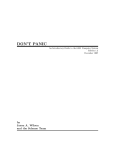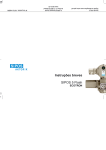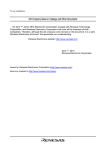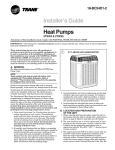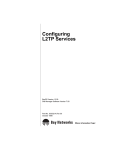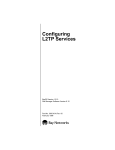Download Vi Editor User's Guide
Transcript
3
CHAPT ER
Vi Editor User’s Guide
This chapter contains a user’s guide to the vi editor, adapted from the LynxOS documentation set for
LightStream 2020 users. It is organized as follows:
•
•
•
•
•
•
•
•
•
•
•
•
Introduction
Editing Basics
Terminology
vi Regular Expressions
Position Movement Commands
Secondary Movement Commands
Text-Changing Commands
Colon Commands
Miscellaneous Commands
Editor Initialization
Command Summary
Notes on LynxOS vi
Introduction
The vi program is a full-screen text editor for creating and modifying files. Although it was designed
for use as a software development tool, vi is suitable for a wide variety of editing tasks
The vi program determines the type of terminal on which it is being run by examining the TERM
environment variable and the /etc/termcap file (or the TERMCAP environment variable). Any
terminal defined in the /etc/termcap file can be used, as long as it supports at least cursor positioning
and screen erase. On a LightStream 2020 node, TERM is set to vt100 in the .profile command file at
login time. To change the value, type TERM=value at the bash prompt. For example, to set it to
xterm, enter the following commands:
LSnode:1$ TERM=xterm
LSnode:1$ tset
LSnode:1$
See the LightStream 2020 Installation Guide for instructions for changing the default terminal type
that takes effect upon logging in.
Vi Editor User’s Guide 3-1
Editing Basics
Editing Basics
If vi is started with no arguments, it creates a new, empty file which can be given a name and written
to disk at any time. It may be started with the name of a new or existing file on the command line.
(See Editor Initialization on page 10 for more details.)
The editor marks lines on the screen which are not part of the file with a single tilde (~). The editor
always forces at least one line to exist.
The editor is always in command mode or insert mode (with some variants of insert mode).
Command mode is the initial state of the editor, and is the mode from which nearly all editing
commands are issued. Insert mode is used to add or modify text. Several commands switch the editor
from command mode to insert mode, with side effects described below.
Getting Started
Because of the way vi is designed, one must know a large number of commands before editing
becomes really convenient. However, a few simple commands are enough for rudimentary file
operations, and are certainly enough for a careful typist to create new documents.
The first thing to learn is how to get to insert mode, since this is the normal way to add text to a file.
The editor starts in command mode, and the entire keyboard is “hot”: any key pressed results in
immediate action of some kind. The i key puts the editor in insert mode. Unfortunately, there is no
indication of this change, visual or otherwise. In insert mode, all printable characters that are typed
are inserted into the file before the current character. The return key terminates a line and moves to
the next line on the screen. The backspace key (^H, control-H) can be used to back up and fix typing
errors, but only within the current line. Similarly, ^W erases over the most recently typed word, and
^U erases up to the beginning of the line.
The [Esc] key, or control-[, returns from insert mode to command mode. In command mode, the h
key moves one character left, l moves one character right, k moves one line up, and j moves one line
down. (These keys form the line hjkl on the keyboard.) The editor sounds the bell if it is asked to
move to a meaningless position, such as before the beginning of a line or after the end of the file.
The x key deletes individual characters. To delete a line, type d twice in succession. If something is
deleted accidentally, recover it by typing u. Type i to re-enter insert mode at any time.
There are two ways to terminate the editing session. Type uppercase Z twice to save the current file
and leave the editor. Type the string :q! plus carriage return to abort the editing session without
saving changes made to the file.
Terminology
The following terms are used in the descriptions of commands:
Table 3-1
Terms Used in Command Descriptions
Term
Definition
text
Any series of ASCII characters.
buffer
A unit of memory used to hold text.
file buffer
The buffer that holds the file being edited.
white space
Tabs and spaces.
3-2 LightStream 2020 NP O/S Reference Manual
vi Regular Expressions
Term
Definition
word
An unbroken string of (1) letters, digits, and underscores (“_”), or (2) characters
other than letters, digits, underscores, and white space, depending upon context.
big word
An unbroken string of characters other than white space.
unnamed buffer
A buffer containing the last text yanked or deleted.
window
The part of the file that is visible on the terminal.
line
A string of characters followed by a newline character. A “line” of text may take
up more than one row on the screen.
current character
The character beneath the cursor.
current line
The line containing the cursor.
^x
Control character x, e.g. ^B means control-B (ASCII 2).
return
^M or the [Return] key.
command mode
The normal operating mode of the editor. Each key typed is taken as a command.
insert mode
The mode used for manually adding text to a file. Characters that are typed while
in insert mode are inserted into the text.
replace mode
Like insert mode, except that characters typed replace characters in the buffer.
char
Any ASCII character.
named buffer
One of 26 buffers with names “a” through “z”.
mark name
A lowercase letter that names one of 26 marks that can be used to save a position in
the file buffer.
vi Regular Expressions
Regular expressions are usually used for searching. Most characters match themselves in a search
request, but the characters shown in the following table have special meanings:
Table 3-2
Expression
Regular Expressions Used in vi
Definition
-
Matches any single character.
[chars]
Matches any char listed in the brackets. [x-y] is a range of characters, where the
ASCII value of x precedes that of y.
[^chars]
Matches any char not listed in the brackets.
^
Matches the beginning of a line when used as the first character in a regular
expression.
$
Matches the end of a line when used as the last character in a regular expression.
*
Matches zero or more instances of the preceding item, which may be a normal
char or a 1-character “wildcard” such as . or [chars].
+
Matches one or more instances of the preceding item.
?
Matches zero or one instances of the preceding item.
\<
Matches the beginning of a word
\>
Matches the end of a word.
Vi Editor User’s Guide 3-3
Position Movement Commands
This feature may be turned off with the command set nomagic, as described on page 10. To search
for one of these special characters, precede it by a backslash to prevent special interpretation. When
special searching characters make several matches possible in a single line, vi matches the longest
string possible. This becomes important for search-replace commands.
Note Parentheses and angle brackets are interpreted literally, and need not be preceded with
backslashes.
Position Movement Commands
There are two kinds of movement commands. Position movement commands move the current
position in the file based on file contents. These commands are shown in the following table. Note
that uppercase and lowercase letters are distinct. There are commands for nearly every editing
situation, but only a few are needed by beginners for simple editing.
With most position movement commands, optionally type an integer n before the command (with
no space) to repeat the movement n times. The default is 1.
Table 3-3
Position Movement Commands
Command
Description
nh (or n^H)
Left n characters (1 by default). Within current line only.
nj (or n^J,
or n^N)
Down n lines (1 by default), in the same column if possible.
nk (or n^K)
Up n lines (1 by default), in the same column if possible.
nl (or n^L,
or nspace)
Right n characters (1 by default).
^I
Forward to the next tab stop.
nw
Forward to the beginning of the nth following word.
nW
Forward to the beginning of the nth following big word.
nb
Back to the beginning of the nth previous word.
nB
Back to the beginning of the nth previous big word.
ne
Forward to the end of the nth following word.
nE
Forward to the end of the nth following big word.
nG
The nth line of the file (default, last line).
0
The first character of the current line.
_
(or
^)
The first non-whitespace character on the current line.
$
The end of the current line.
%
The matching parenthesis, bracket, or brace.
’mark
(Single quote.) The beginning of the line previously marked with mark (a single
lowercase letter).
’’
If mark is ’, move to the beginning of the line that was current just before the
last absolute movement command such as G, %, or ’ itself.
3-4 LightStream 2020 NP O/S Reference Manual
Secondary Movement Commands
Command
‘mark
‘‘
Description
(Back quote.) The position (line and column) previously marked with mark (a
single lowercase letter).
If mark is ‘ (back quote), move to the position that was current just before the
last absolute movement command.
n+
The first non-whitespace character on the nth line below.
n-
The first non-whitespace character on the nth line above.
/
Search forward. Prompts on the last line of the screen for a search pattern
(default = last pattern searched for).
?
Search backward. Prompts on the last line of the screen for a search pattern
(default = last pattern searched for).
n
Search forward for last pattern searched for.
N
Search backward for last pattern searched for.
fchar
Next instance of char on current line.
tchar
Character preceding next instance of char on current line.
Fchar
Previous instance of char on current line.
Tchar
Character following previous instance of char on current line.
;
Repeat last t or f command.
,
Repeat last T or F command.
nH
Beginning of nth line from top of text (default = 1, home).
nL
Beginning of line nth row from bottom of text (default = 1).
n^M
First non-whitespace character on the nth line below (default = carriage return).
All the position movement commands can be used as operands to various change, delete, and
substitute commands described farther on.
Secondary Movement Commands
Use secondary movement commands to move quickly through the file or to reposition the window
in the file. Secondary movement commands cannot be used as operands to commands that change
text.
Table 3-4
Command
Secondary Movement Commands
Description
^B
Move a full window backward.
^D
Move half a window forward.
^E
Move the window down one line. The cursor moves only if the current line scrolls off
the screen.
^F
Move a full window forward.
^U
Move half a window backward.
^Y
Move the window up one line. The cursor moves only if the current line scrolls off the
screen.
Vi Editor User’s Guide 3-5
Text-Changing Commands
Command
Description
z.
Scroll the current line to the middle of the window.
z-
Scroll the current line to the bottom of the window.
z[Return]
Scroll the current line to the top of the window.
Text-Changing Commands
There are two kinds of commands that change text, those that are used with arguments and operands
(movement commands), and those that are used alone.
The effect of any command that changes text can be repeated with the . command, or undone with
the u or U command. Consequently, the sequence of entering insert mode, adding text, and returning
to command mode can be repeated several times, or undone if the added text is unsatisfactory.
Several of the text-changing commands put a copy of the changed text into the unnamed buffer.
These commands , are c, d, s, x, and X. Use p or P to retrieve the changed text.
Text-Changing Commands With Operands
The most important of the text-changing commands in vi operate on a variable region of text
determined by an argument or operand of the command. For example, with a single command one
may change the next three words, or delete lines up to the first instance of some pattern, or
horizontally shift lines between the current position and some marked line.
Each of the commands that take operators or arguments is normally followed by one of the primary
movement commands. The current cursor position defines one end of the region to be changed, and
the movement command defines the other end. Alternatively, if a command is doubled, it affects the
entire current line; for example, dd deletes the current line. If a repeat count n is included, it can be
typed before the change command or before the movement command.
Table 3-5
Command
To Change a Region Delimited by a Movement Command
Description
c
Change the region of text delimited by the movement operand. If the end of the text region is
within the current line, vi marks it with a $ mark (dollar sign), enters replace mode until the
cursor reaches the $ mark, and then enters insert mode for additional typing. Otherwise, vi
deletes text from the current position through the end of the region and enters insert mode.
d
Delete the region of text. Equivalent to using c and immediately pressing [Esc] to leave
insert mode.
y
Copy text unchanged from the region to the unnamed buffer.
<
Shift each line of the region left one tab stop.
>
Shift each line of the region right one tab stop.
!
Filter the region through a LynxOS utility or other program. Prompts for a command.
Standard output of the command replaces the text in the region.
3-6 LightStream 2020 NP O/S Reference Manual
Text-Changing Commands
Text-Changing Commands Without Operands
Other text-changing commands do not require operands, because they operate on predefined regions
of text, such as individual characters or lines, and enter insert mode in various ways. A repeat count
n may be given with many of these commands (default = 1).
Table 3-6
Command
To Change a Predefined Text Object
Description
i
Enter insert mode before the current character.
I
Move to the first non-whitespace character of the current line and enter insert mode.
a
Enter insert mode after the current character.
A
Move to the last character of the current line and enter insert mode after that character.
o
Add a blank line below the current line, move to the new line, and enter insert mode.
O
Add a blank line above the current line, move to the new line, and enter insert mode.
nx
Delete n characters to the right, starting with current character.
nX
Delete n characters to the left of current character.
J
Join the next line with the current line.
np
Insert text from the unnamed buffer n times after the current position. Insert after the current
line if the buffer contains lines of text.
nP
Insert text from the unnamed buffer n times before the current position. Insert before the
current line if the buffer contains lines of text.
R
Enter replace mode, a variant of insert mode. Typing overwrites characters on the current
line. As soon as the current line is completely overwritten, enter insert mode.
rchar
Replace the current character with char.
s
Change the current character (same as c1).
C
Change the text in the current line (same as c$).
C
Delete the remainder of the current line (same as d$).
Y
Copy the remainder of the current line into the unnamed buffer (same as y$).
S
Change the current line (same as cc).
u
Undo the effects of the last text-changing command.
U
Multi-level undoing through the 9 most recent changes. (By contrast, repeating u has no net
effect on the file.)
&
Repeat last search/replace command (see Colon Commands).
~
Repeat the effect of the last text-changing command.
.
Change case (uppercase or lowercase) of the current character, if it is alphabetic, and move
right one character.
Vi Editor User’s Guide 3-7
Miscellaneous Commands
Miscellaneous Commands
The following commands are useful and important but defy ready categorization:
Table 3-7
Command
Miscellaneous Commands
Description
mmark
Mark the current line with mark, a single lowercase letter, for future reference by movement
and change commands.
^R
Redraw the screen.
^G
Display information about the current position and file buffer.
^^
Toggle between the current file buffer and the last file buffer edited.
”letter
Use the buffer named letter for the following command. P or p inserts from letter instead of
from the unnamed buffer, and commands that write into the unnamed buffer write into letter
as well.
@letter
Perform commands found in the buffer named letter as if they were typed on the keyboard.
To put commands into a buffer, create a new line in the main file and then delete it into the
buffer. The . command repeats the effects of an invocation of buffered commands; the u and
U commands repeat the effects of individual commands in the buffer.
^]
Interpret characters from the current position to the end of the word as a tag name, and go to
that tag position. If this requires editing a new file, the current file must first be saved or the
autowrite flag must be set. (See the ta command on page .)
ZZ
Save the current file and leave vi. (See also :xit on page .)
^C
Abort a search in progress or a colon command being entered.
^Z
Put the current editing session in the background and return to the invoking shell. To resume
editing, use the appropriate shell command to bring vi back into the foreground.
Colon Commands
The : command accesses a family of commands which cannot easily be expressed by one or two
keystrokes.
•
•
•
When : is typed, vi prompts for a colon command.
Colon commands may be abbreviated: one need type only enough characters to distinguish the
intended command from other colon commands, then press [Return] or [Esc] to terminate the
command.
Several colon commands can be put on a single line separated by | characters, in the manner of a
shell pipeline.
3-8 LightStream 2020 NP O/S Reference Manual
Colon Commands
Colon Commands with a Range of Lines
The following colon commands operate on a range of lines within a file:
Table 3-8
Colon Commands
Command
Description
range s/pat/repl/g
The s command substitutes the replacement text repl in place of the pattern text pat
on each line included in the range. If range is omitted, the default is the current line.
If the optional g is included at the end of the command, each occurrence of pat is
replaced, otherwise only the first instance on each line is affected.
The pattern pat may be any regular expression (see page ). If the replacement string
repl contains the character &, the current instance of pat is substituted for it. If the
replacement string repl contains the sequence \n, where n is a single digit from 1 to 9,
that sequence is replaced by the nth portion of pat that is bracketed by \( and \).
Examples:
Change every instance of cat to dog:
:%s/cat/dog/g
Remove all leading and training spaces in a file:
:%s/^ *\(.*[^ ]\) *$.\1
Note that the pattern grouped in \( and \) explicitly specifies that the pattern end with
a non-space. This is because vi always matches the longest patterns and sub-patterns.
Parenthesize the first string of capital letters on the current line:
:s/[A-Z]+/(&)/
range w file
range w! file
range w>> file
Write the lines in range to file. If range is omitted, write the entire file; in the absence
of file, use the current file name. Use w! to overwrite an existing file. Use w>> to
append to the end of an existing file.
The range parameter of the above commands consists of one or two of the following line specifiers:
Table 3-9
Line Specifier Strings Used to Specify Range of Colon Commands
Specifier
Definition
.
The current line.
$
The last line of the file.
n
Line number n of the file (a decimal integer).
’mark
Line previously marked by the 1-character mark with the m command.
If range consists of only one line specifier, it selects just that one line. If range consists of two line
specifiers separated by a comma, it selects all lines from the first to the second, inclusive, regardless
of the order in which the two line specifiers are entered. If no range is given, the default may be the
current line or the entire file, depending on the command. The range specifier % is an abbreviation
for 1,$, selecting the entire file.
Vi Editor User’s Guide 3-9
Colon Commands
Colon Commands That Specify Files
The colon commands described in the following table determine the file to be edited:
Table 3-10
Colon Commands That Determine the File Being Edited
Command
Description
edit file
Start editing another file. If file is not given, the default is to reload the version of the current
file found on disk (the last saved version, or the original if it has not been saved). If file is #,
then vi switches to the alternate file, which is either the most recent file edited in this vi
session, or the file most recently named in a colon command, even if that command failed.
If the current file has not been saved, vi does not switch files unless the autowrite flag is set.
It may be forced to switch by typing edit! file, but all changes to the current file are then
lost.
next
Edit the next file in the parameter list that was given when vi was invoked. If the current file
has not been saved, vi does not switch files unless the autowrite flag is set. It may be forced
to switch by typing next!, but all changes to the current file are then lost.
quit
Exit vi. If the current file has not been saved, vi does not terminate unless the autowrite flag
is set. It may be forced to exit by typing quit!, but all changes to the current file are then
lost.
read file
Read the contents of file into the file buffer after the current line.
rewind
Change to the first parameter in the parameter list given when vi was invoked. The other
parameters in the list can then be reexamined with the next command. If the current file has
not been saved, vi does not switch files unless the autowrite flag is set. It may be forced to
switch by typing rewind!, but all changes to the current file are then lost.
ta tag
Look up the string tag in a file named tags in the current working directory. Lines in this file
are of the following form:
tag filename pattern
When it finds tag, vi changes to the file filename (if it is different from the current file) and
moves to the first instance of pattern in that file. The tags file is usually constructed
automatically, by the ctags program if the files contain C source code, or by some other
program for other types of files. If the current file has not been saved, vi does not switch
files unless the autowrite flag is set. It may be forced to switch by typing ta! tag, but all
changes to the current file are then lost.
xit
Exit vi after saving the current file buffer. (See also ZZ on page .)
3-10 LightStream 2020 NP O/S Reference Manual
Colon Commands
Commands That Tailor the Editing Environment
Several colon commands can be used to create keyboard shortcuts. The :set command can be used
to manipulate the vi editor parameters described in the table on page 10.‘‘ These commands are as
follows:
Table 3-11
Commands That Tailor the Editing Environment
Command
Description
map key string
Assign user-definable strings to particular characters. If key is typed in command
mode, vi behaves as if string had been typed instead (but see below for map!).
If key is typed in insert mode, vi behaves as if string had been typed instead.
map! key string
The same key can be used twice, once for insert mode and once for command mode.
unmap key
Remove any mapping established for key in command mode.
unmap! key
Remove any mapping established for key in insert mode.
set flag
Set flag to TRUE.
set noflag
Set flag to FALSE.
set var=value
Set var to the numeric value value.
The following vi editor parameters may be manipulated by :set commands.
Table 3-12
Editor Parameters That May be Set With the set Command
Parameter
Description
autoindent
If set, when text is added vi indents each new line by the same amount as the previous
line.
autowrite
If set, vi writes the file to disk automatically when it switches between files or when it
is stopped with ^Z.
ignorecase
If set, search commands ignore case.
list
If set, tabs in the file are made visible on the screen as ^I.
magic
If not set (set nomagic), special characters described on page need not be quoted
with a backslash.
tabstop
Width in spaces of a tab stop; used also for shifting text.
wrapscan
If set, searches wrap around from one end of the file to the other.
Vi Editor User’s Guide 3-11
Editor Initialization
Editor Initialization
When vi starts up, it looks for the variable VIINIT in the user’s shell environment. If VIINIT is not
set, vi looks for a file called .virc in the user’s home directory. What it looks for is a list of colon
commands, delimited by newlines, which it executes.
After executing commands found in VIINIT or $HOME/.virc, then vi looks for a .virc file in the
current working directory. Because the commands in a local .virc take effect after those described
above, the local file may be used to set parameters for editing a special set of files grouped in one
directory.
If vi is started with the -t option, it uses a tag file created by ctags or some other method to start and
load the file containing a requested tag. If a positioning command (see page 3) is given before any
tag or file names, vi starts at the specified position rather than at the beginning of the file.
Command Summary
The following table lists all of the vi commands, as described above, in ASCII order. Unused
characters are noted.
Table 3-13
Command
Command-Mode Command Summary
Description
^A
Not used.
^B
Move a full window backward.
^C
Abort a search in progress or a colon command being entered.
^D
Move half a window forward.
^E
Move the window down one line. The cursor moves only if the current line scrolls off the
screen.
^F
Move a full window forward.
^G
Display information about the current position and file buffer.
n^H
Left n characters (1 by default). Within current line only.
^I
Forward to the next tab stop.
n^J
Down n lines (1 by default), in the same column if possible.
n^K
Up n lines (1 by default), in the same column if possible.
n^L
Right n characters (1 by default).
n^M
First non-whitespace character on the nth line below (default = carriage return).
n^N
Down n lines (1 by default), in the same column if possible.
^O
Not used.
^P
Not used.
^Q
Not used (XON character for flow control).
^R
Redraw the screen.
^S
Not used (XOFF character for flow control).
^T
Not used.
^U
Move half a window backward.
3-12 LightStream 2020 NP O/S Reference Manual
Command Summary
Command
Description
^V
Not used.
^W
Not used.
^X
Not used.
^Y
Move the window up one line. The cursor moves only if the current line scrolls off the
screen.
^Z
Put the current editing session in the background and return to the invoking shell. To
resume editing, use the appropriate shell command to bring vi back into the foreground.
^[
Not used in command mode (exits insert mode).
^\
Not used.
^]
Interpret characters from the current position to the end of the word as a tag name, and go
to that tag position. If this requires editing a new file, the current file must first be saved or
the autowrite flag must be set. (See the ta command below under Colon Commands.)
^^
Toggle between the current file buffer and the last file buffer edited.
^_
Not used.
n[space]
Right n characters (1 by default).
!
Filter the region through a LynxOS utility or other program. Prompts for a command.
Standard output of the command replaces the text in the region.
”letter
Use the buffer named letter for the following command. P or p inserts from letter instead
of from the unnamed buffer, and commands that write into the unnamed buffer write into
letter as well.
#
Not used.
$
The end of the current line.
%
The matching parenthesis, bracket, or brace.
&
Repeat last search/replace command (see Colon Commands).
’mark
(Single quote.) The beginning of the line previously marked with mark (a single
lowercase letter).
’’
If mark is ’ (single quote) , move to the beginning of the line that was current just before
the last absolute movement command such as G, %, or ’ itself.
(
Not used.
)
Not used.
*
Not used.
n+
The first non-whitespace character on the nth line below.
’
(Single quote.) Repeat last T or F command.
n-
The first non-whitespace character on the nth line above.
.
Repeat the effect of the last text-changing command.
/
Search forward. Prompts on the last line of the screen for a search pattern (default = last
pattern searched for).
0
The first character of the current line.
1...9
Not used, except to specify repeat counts to other commands.
:
Used to introduce a colon command.
;
Repeat last t or f command.
<
Shift each line of the region left one tab stop.
Vi Editor User’s Guide 3-13
Command Summary
Command
Description
=
Not used.
>
Shift each line of the region right one tab stop.
?
Search backward. Prompts on the last line of the screen for a search pattern (default = last
pattern searched for).
@letter
Perform commands found in the buffer named letter as if they were typed on the keyboard.
Put commands into a buffer by creating a new line in the main file and then deleting it into
the buffer. Use the . command to repeat the effects of an invocation of buffered commands;
u and U commands only repeat the effects of individual commands in the buffer.
A
Move to the last character of the current line and enter insert mode after that character.
nB
Back to the beginning of the nth previous big word.
C
Change text in the current line (same as c$).
D
Delete remainder of the current line (same as d$).
nE
Forward to the end of the nth following big word.
Fchar
Previous instance of char on current line.
nG
The nth line of the file (default, last line).
nH
Beginning of nth line from top of text (default = 1, home).
I
Move to the first non-whitespace character of the current line and enter insert mode.
J
Join the next line with the current line.
K
Not used.
nL
Beginning of line nth row from bottom of text (default = 1).
M
Not used.
N
Search backward for last pattern searched for.
O
Add a blank line above the current line, move to the new line, and enter insert mode.
nP
Insert text from the unnamed buffer n times before the current position. Insert before the
current line if the buffer contains lines of text.
Q
Not used.
R
Enter replace mode, a variant of insert mode. Typing overwrites characters on the current
line. As soon as the current line is completely overwritten, enter insert mode.
S
Change the current line (same as cc).
Tchar
Character following previous instance of char on current line.
U
Multi-level undoing through the 9 most recent changes. (By contrast, repeating u has no
net effect on the file.)
V
Not used.
nW
Forward to the beginning of the nth following big word.
nX
Delete n characters to the left of current character.
Y
Copy remainder of the current line into the unnamed buffer (same as y$).
ZZ
Save the current file and leave vi.
[
Not used.
\
Not used.
]
Not used.
^
The first non-whitespace character on the current line.
3-14 LightStream 2020 NP O/S Reference Manual
Command Summary
Command
Description
_
The first non-whitespace character on the current line.
‘mark
The position (line and column) previously marked with mark (a single lowercase letter).
‘‘
If mark is ‘, move to the position that was current just before the last absolute movement
command.
a
Enter insert mode after the current character.
nb
Back to the beginning of the nth previous word.
c
Change the region of text delimited by the movement operand. If the end of the text region
is within the current line, vi marks it with a $ mark (dollar sign), enters replace mode until
the cursor reaches the $ mark, and then enters insert mode for additional typing.
Otherwise, vi deletes text from the current position through the end of the region and
enters insert mode.
d
Delete the region of text. Equivalent to using c and immediately pressing [Esc] to leave
insert mode.
ne
Forward to the end of the nth following word.
fchar
Next instance of char on current line.
g
Not used.
nh
Left n characters (1 by default). Within current line only.
i
Enter insert mode before the current character.
nj
Down n lines (1 by default), in the same column if possible.
nk
Up n lines (1 by default), in the same column if possible.
nl
Right n characters (1 by default).
mmark
Mark the current line with mark, a single lowercase letter, for future reference by
movement and change commands.
n
Search forward for last pattern searched for.
o
Add a blank line below the current line, move to the new line, and enter insert mode.
np
Insert text from the unnamed buffer n times after the current position. Insert after the
current line if the buffer contains lines of text.
q
Not used.
rchar
Replace the current character with char.
s
Change the current character (same as c1).
tchar
Character preceding next instance of char on current line.
u
Undo the effects of the last text-changing command.
v
Not used.
nw
Forward to the beginning of the nth following word.
nx
Delete n characters to the right, starting with current character.
y
Copy text unchanged from the region to the unnamed buffer.
zreturn
Scroll the current line to the top of the window.
z-
Scroll the current line to the bottom of the window.
z.
Scroll the current line to the middle of the window.
{
Not used.
|
Not used.
}
Not used.
Vi Editor User’s Guide 3-15
Notes on LynxOS vi
Command
~
Description
Change case (uppercase or lowercase) of the current character, if it is alphabetic, and move
right one character.
Notes on LynxOS vi
The following list summarizes the salient differences between the version of vi running under
LynxOS and other popular versions of the vi editor. Many of the differences are enhancements.
Differences that reflect bugs found in other versions are not listed here.
•
U undoes the last text change for up to 9 changes. In other versions, U undoes all changes made
to the current line since it became the current line.
•
After an undo command that causes a change in file position, LynxOS vi remembers the previous
position so that ’’ returns.
•
The unnamed buffer is not deleted after the edit colon command so that text can be more easily
transferred from one file to another.
•
•
the p and P commands accept a repeat count.
•
•
The + and ? regular expression operators are supported.
•
•
•
There is no “open” mode, a terminal must support cursor movement to be used with LynxOS vi.
•
LynxOS vi reads startup commands from the VIINIT environment variable instead of the
EXINIT variable.
Backspace can be used to delete whitespace inserted automatically in autoindent mode. Other vi
versions only recognize ^D for this purpose.
The Y command is defined as y$ to be consistent with the C and D commands. Other versions
of vi treat Y as if it were yy.
All shift commands can be repeated with the . command.
The n command always searches forward, and the N command always searches backward. In
other versions of vi, the n command searches in the most recent search direction and N searches
in the opposite of the most recent direction.
3-16 LightStream 2020 NP O/S Reference Manual
Notes on LynxOS vi
Vi Editor User’s Guide 3-17



















